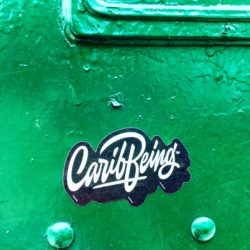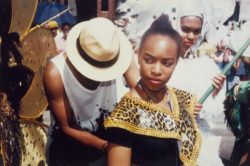When Yes Means No: Consent in Carnival Culture
August 25, 2017 7:34 pmDiscussion of Carnival and J’Ouvert continues at 2 pm Sat, August 26, at the Brooklyn Museum

“Is this a space where a woman is boss?” Shelley Worrell asked the panelists at a roundtable at the Brooklyn Museum last week. The creator of CaribBEING, the mobile cultural venue now in residency at the museum, was referring to Brooklyn’s West Indian Day Parade, and Carnival celebrations around the world.
“I think a woman is definitely boss when it comes to Carnival – the costumes, the mas, everything,” said Lyrikal, a soca artist born in Trinidad who moved to New York at 13. He now performs at Carnival internationally.
“More women play mas (joining a masquerade band) then men,” said panelist Rosamond King, associate English professor at Brooklyn College. But there’s pressure on the performance. The challenge lingers, “Are you West Indian only on Labor Day, or all year around?”
Rosamond King, author of Island Bodies: Transgressive Sexualities in the Caribbean Imagination, teaches courses in Caribbean and African literature, creative writing, sexuality, performance, and immigrant literature.
Carnival is a complex environment for women. In Brooklyn, it’s also been dangerous. Both men and women, young and old, have been the victims of shootings for years. Tiarah Poyau, a 22-year-old graduate student at St. John’s University, was shot to death last year after she told a man to stop grinding on her, according to news reports. He was apprehended after drunkenly crashing his car.
Dancing shouldn’t be a threat, Lyrikal said. If a woman isn’t interested, one look should be enough to discourage him.
“If she gives you that look like, ‘Back up,’ you back up,” he said. “There’s no reason why any guy should want to force a female to dance with him. Everything’s about understanding the culture. It’s not really about wining. It’s about freedom and celebrating. It stems from J’Ouvert, and from slaves being freed.”
Not everyone understands Carnival, said panelist Pastor Gil Montrose, who has worked with the New York Police Department on its response to the 1-3 million Labor Day revelers, annually.
When some Brooklynites, generations removed from the Caribbean, and from all corners of the world, “see a woman in costume, they’re not looking for culture,” Pastor Montrose said. “They’re looking for a good time. But it’s not just a big party.”
People attending the discussion suggested more education on Carnival in the community. King encouraged the room to elect local leaders who will promote and preserve Island culture.
“I think a good weekend would be one where everyone can get home safely,” said Montrose, Senior Pastor at Mt. Zion Church Of God and Founding President of the 67th Precinct Clergy Council. “Where I don’t have to perform any funerals in September.”
The STAR Program took an interest in the discussion because of its connection to public health, and sexual health, in Brooklyn.
The Caribbeing House is a mobile cultural hub that stands at the crossroads of culture, art and film. Check it out now, in residency at the Brooklyn Museum, “share your Caribbean heritage story with CUNY’s Dominican Studies Institute, contribute to a collective Caribbean Newsstand with artist Lizania Cruz, and see intimate photographs of Brooklyn’s own Jean-Michel Basquiat by Alexis Adler.” Free and open to the public.

Catherine Green (American, born 1952). Untitled, 1991. Brooklyn Museum.
Categorised in: News
This post was written by suny-admin

Comments are closed here.